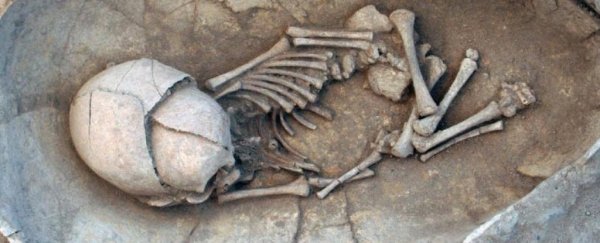The rate of childhood death in prehistoric times was not nearly as dire as we've been led to believe, according to new research.
It's often reported that nearly 40 percent of all prehistoric babies died within the first year of their lives. But when anthropologists in Australia analyzed a decade's worth of modern United Nations (UN) population data from 97 countries, they found evidence that could challenge this popular belief.
Instead, the estimate seems to be based on the erroneous assumption that infant mortality rates determine how many humans die in childhood, rather than reflecting fertility rates.
"It has long been assumed that if there are a lot of deceased babies in a burial sample, then infant mortality must have been high," explains anthropologist Clare McFadden from the Australian National University.
"Many have assumed that infant mortality was very high in the past in the absence of modern healthcare. When we look at these burial samples, it actually tells us more about the number of babies that were born and tells us very little about the number of babies that were dying, which is counterintuitive to past perceptions."
In other words, the researchers suggest that the number of children buried in ancient times seems to be a stronger indicator of the rate at which babies were being born, not the rate at which they were dying.
Ancient burial sites are some of the best evidence we have of how humans lived in prehistoric times, thousands of years ago, but these sites don't always give us a lot of physical evidence to go on, meaning it's possible to misinterpret what we find.
After all, when a larger number of infants are born, more infants will die, even if the rate of death remains stable.
Researchers have now shown this is true among children born in the past decade.
As expected, today's death rate for stillborn children, neonates, infants, and children under 5 years of age, is most strongly predicted by the total fertility rate, although the number of kids being born still doesn't explain all childhood deaths.
Up to 40 percent of the variation seems to be due to other unknown factors – probably a complex interplay of variables.
Even the fertility rate itself speaks to a range of other factors, like socioeconomic status, malnourishment, disease, and access to care, which can all potentially interact with one another.
"[T]his suggests that the ratios tested are not particularly effective proxies for infant and juvenile mortality," the authors write.
"Therefore," they add, "the influence of fertility on infant mortality rates is highly complex and should not be considered causal without supporting evidence."
Interestingly, in some 'low fertility' nations like Japan and Iceland, the fertility rate was even stronger at influencing the infant mortality rate.
In nations with high fertility, like Mali, on the other hand, there was a relatively higher proportion of childhood death, even compared to nations with a higher infant mortality rate, like Sierra Leone.
Clearly, the rate of childhood death in Mali isn't entirely due to its lower infant mortality rate and has more to do with how many babies are being born.
In light of these results, researchers say we need to seek a more holistic and contextual approach to how we interpret ancient baby burials. Just because there are a lot of buried children in ancient times, doesn't necessarily mean prehistoric mothers struggled to care for their kids.
"If mothers during that time were having a lot of babies, then it seems reasonable to suggest they were capable of caring for their young children," says McFadden.
"Artistic representations and popular culture tend to view our ancestors as these archaic and incapable people, and we forget their emotional experience and responses such as the desire to provide care and feelings of grief date back tens of thousands of years, so adding this emotional and empathetic aspect to the human narrative is really important."
The study was published in the American Journal of Biological Anthropology.
